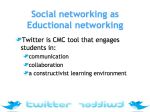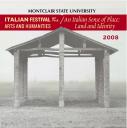Why we learn foreign languages…to understand better the world in which we are living thus, in turn, understand ourselves and our homeland better. Except, with globalization people think barriers are being removed and everyone should just be able to speak English, since it is considered a global language.
But that is not globalization. Cultural globalization does not aim for homogeny, it rather foresees a growth of cross-cultural contacts, something that is dear to me as a language professor. Understandably, teaching foreign languages occurs in a rather artificial environment (the classroom) since the professor is the only contact with the target language that a student has. With technological tools, this is no longer the case. Culture and language can be explored via different tools to bring the reality of the target language to life in and out of the classroom. In previous posts, I have discussed my personal exploitation of technology in the classroom, and, yes, I have explored Twitter ad infinitum.
And it is to Twitter that I return for this post too. Except now I am not alone. Just before the Christmas holidays, I chatted with @sethdickens (whom I know solely from following him on Twitter) and I proposed creating a community on Twitter for both his students and mine. This e-twinning proposal excited us both and we decided to use Twitter for 1) my grammar and composition course in Italian and 2) my Contemporary Italian Cultural Studies in English. Seth was agreeable and introduced his Italian high school seniors from his philosophy and history course to both of my classes.
We are in our third week on Twitter. Seth has prepared for everyone in our community a wiki to introduce and provide details for this project. Just amazing.
So far, I have been rather laidback giving students an opportunity to explore Twitter (again, for the majority of students, Twitter was a new social networking tool) and get comfortable with the text limitations, language use and course requirement (3 general tweets a week, 1 reply tweet to another community member). As past experience has shown me, some students tweet away while others wonder why they should tweet.
Some exciting conversations have taken place, but with either myself or Seth at the helm of the discussion. The prompts that we provide have led our respective students to engage with us in the target language and Seth’s students have engaged with me and vice-versa. Just the other day, there was some good exchanges between our students, which pleased us to no end. To many of you reading this, you’re probably thinking that “it really ain’t much” but the truth is, yes it is. For students to feel comfortable enough to engage in the foreign language to discuss and assist other language learners is a great accomplishment. Knowledge, linguistic and cultural, is being constructed by the learners, and the scaffolding of new skills and concepts is evident.
Read for yourself:
In the culture course, the talk of some current events in Italy led to students contributing to the talk and wanting to learn more from one another.

In the grammar course, learning new vocabulary was the impetus of the exchange.

In both exchanges, I would hope that students did, even momentarily, recognize the value of Twitter, both in synchronous exchanges (the second example) and asynchronous (given the time difference with Italy).
I am really thrilled to have found such an engaged and knowledgeable collaborator (read his blog to learn how talented his is) and I know this e-twinning project this semester will continue to surprise and excite me.







 Italy’s malaise (
Italy’s malaise (